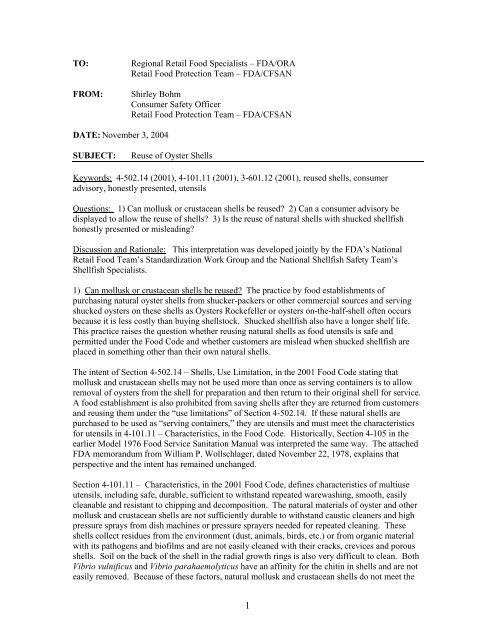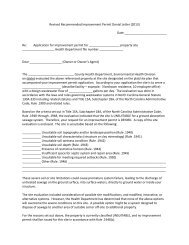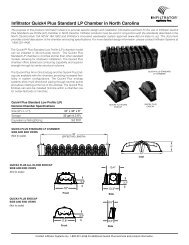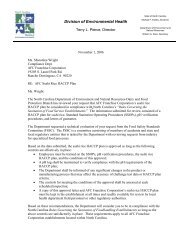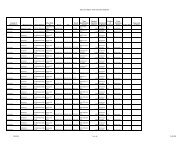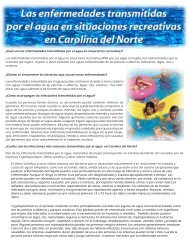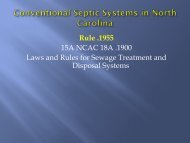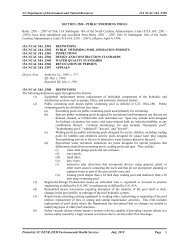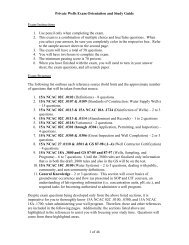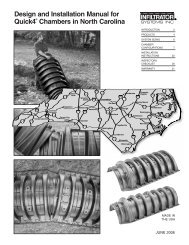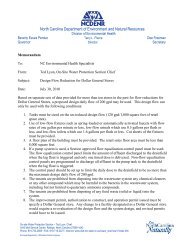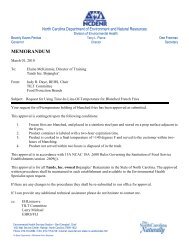Reuse of Oyster Shells - Environmental Health Section
Reuse of Oyster Shells - Environmental Health Section
Reuse of Oyster Shells - Environmental Health Section
You also want an ePaper? Increase the reach of your titles
YUMPU automatically turns print PDFs into web optimized ePapers that Google loves.
TO:<br />
FROM:<br />
Regional Retail Food Specialists – FDA/ORA<br />
Retail Food Protection Team – FDA/CFSAN<br />
Shirley Bohm<br />
Consumer Safety Officer<br />
Retail Food Protection Team – FDA/CFSAN<br />
DATE: November 3, 2004<br />
SUBJECT:<br />
<strong>Reuse</strong> <strong>of</strong> <strong>Oyster</strong> <strong>Shells</strong><br />
Keywords: 4-502.14 (2001), 4-101.11 (2001), 3-601.12 (2001), reused shells, consumer<br />
advisory, honestly presented, utensils<br />
Questions: 1) Can mollusk or crustacean shells be reused 2) Can a consumer advisory be<br />
displayed to allow the reuse <strong>of</strong> shells 3) Is the reuse <strong>of</strong> natural shells with shucked shellfish<br />
honestly presented or misleading<br />
Discussion and Rationale: This interpretation was developed jointly by the FDA’s National<br />
Retail Food Team’s Standardization Work Group and the National Shellfish Safety Team’s<br />
Shellfish Specialists.<br />
1) Can mollusk or crustacean shells be reused The practice by food establishments <strong>of</strong><br />
purchasing natural oyster shells from shucker-packers or other commercial sources and serving<br />
shucked oysters on these shells as <strong>Oyster</strong>s Rockefeller or oysters on-the-half-shell <strong>of</strong>ten occurs<br />
because it is less costly than buying shellstock. Shucked shellfish also have a longer shelf life.<br />
This practice raises the question whether reusing natural shells as food utensils is safe and<br />
permitted under the Food Code and whether customers are mislead when shucked shellfish are<br />
placed in something other than their own natural shells.<br />
The intent <strong>of</strong> <strong>Section</strong> 4-502.14 – <strong>Shells</strong>, Use Limitation, in the 2001 Food Code stating that<br />
mollusk and crustacean shells may not be used more than once as serving containers is to allow<br />
removal <strong>of</strong> oysters from the shell for preparation and then return to their original shell for service.<br />
A food establishment is also prohibited from saving shells after they are returned from customers<br />
and reusing them under the “use limitations” <strong>of</strong> <strong>Section</strong> 4-502.14. If these natural shells are<br />
purchased to be used as “serving containers,” they are utensils and must meet the characteristics<br />
for utensils in 4-101.11 – Characteristics, in the Food Code. Historically, <strong>Section</strong> 4-105 in the<br />
earlier Model 1976 Food Service Sanitation Manual was interpreted the same way. The attached<br />
FDA memorandum from William P. Wollschlager, dated November 22, 1978, explains that<br />
perspective and the intent has remained unchanged.<br />
<strong>Section</strong> 4-101.11 – Characteristics, in the 2001 Food Code, defines characteristics <strong>of</strong> multiuse<br />
utensils, including safe, durable, sufficient to withstand repeated warewashing, smooth, easily<br />
cleanable and resistant to chipping and decomposition. The natural materials <strong>of</strong> oyster and other<br />
mollusk and crustacean shells are not sufficiently durable to withstand caustic cleaners and high<br />
pressure sprays from dish machines or pressure sprayers needed for repeated cleaning. These<br />
shells collect residues from the environment (dust, animals, birds, etc.) or from organic material<br />
with its pathogens and bi<strong>of</strong>ilms and are not easily cleaned with their cracks, crevices and porous<br />
shells. Soil on the back <strong>of</strong> the shell in the radial growth rings is also very difficult to clean. Both<br />
Vibrio vulnificus and Vibrio parahaemolyticus have an affinity for the chitin in shells and are not<br />
easily removed. Because <strong>of</strong> these factors, natural mollusk and crustacean shells do not meet the<br />
1
criteria for characteristics <strong>of</strong> a multiuse utensil and cannot be reused beyond the limited exception<br />
for preparation <strong>of</strong> the animal and return to its shell associated with <strong>Section</strong> 4-502.14.<br />
2) Can a consumer advisory with its reminder and disclaimer be displayed to allow the reuse <strong>of</strong><br />
shells No, the consumer advisory in <strong>Section</strong> 3-603.11 – Consumer Advisory, in the 2001 Food<br />
Code is related to a warning statement when raw or undercooked animal foods are <strong>of</strong>fered to<br />
consumers in a ready-to-eat form. The consumer advisory is required when raw shellfish are<br />
<strong>of</strong>fered for sale or service but it does not allow the reuse <strong>of</strong> shells.<br />
3) Is the reuse <strong>of</strong> natural shells with shucked shellfish honestly presented or misleading to a<br />
consumer The use <strong>of</strong> commercially available artificial shells intended to be used as a serving<br />
utensil with shucked shellfish is not misleading. If a natural oyster shell is used as a serving<br />
utensil, the assumption is that this is the shell where the oyster developed. This can be verified in<br />
the food establishment by requesting the certification tags <strong>of</strong> the shellstock used which must be<br />
retained 90 days. Certification information for fresh frozen oysters on-the-half-shell can be<br />
verified from the packing invoice or packing container. When natural shells from another source<br />
are reused or when the shells from shellstock served at that facility are reused, this is misleading<br />
and not honestly presented to the consumer as specified in <strong>Section</strong> 3-601.12 – Honestly<br />
Presented, in the 2001 Food Code.<br />
Response: The reuse <strong>of</strong> mollusk and crustacean shells as multiuse utensils is not allowed in food<br />
establishments. This does not include the exception for removal <strong>of</strong> the oyster or other species<br />
from the shell for preparation then returning the animal to the shell for service. The shell itself<br />
may be potentially unsafe for use as a food utensil because <strong>of</strong> residues from natural and<br />
environmental contamination occurring after the mollusk or crustacean is removed. In addition,<br />
natural shells are not durable and easily cleanable. <strong>Reuse</strong>d shells with shucked shellfish would be<br />
considered misleading and not honestly presented. Consumer advisors must be provided when<br />
raw and fresh frozen shellfish are served ready-to-eat but it does not provide any allowance for<br />
the operator <strong>of</strong> a food establishment when reusing shells.<br />
References:<br />
1. Sec. 4-502.14 <strong>Shells</strong>, Use Limitation – 2001 Food Code<br />
2. Sec. 4-101.11 Characteristics – 2001 Food Code<br />
3. 3-601.12 Honestly Presented – 2001 Food Code<br />
4. Correspondence, dated November 22, 1978, from William P. Wollenschlager, FDA,<br />
Division <strong>of</strong> Retail Food Protection regarding Mollusk and Crustacea <strong>Shells</strong><br />
2


